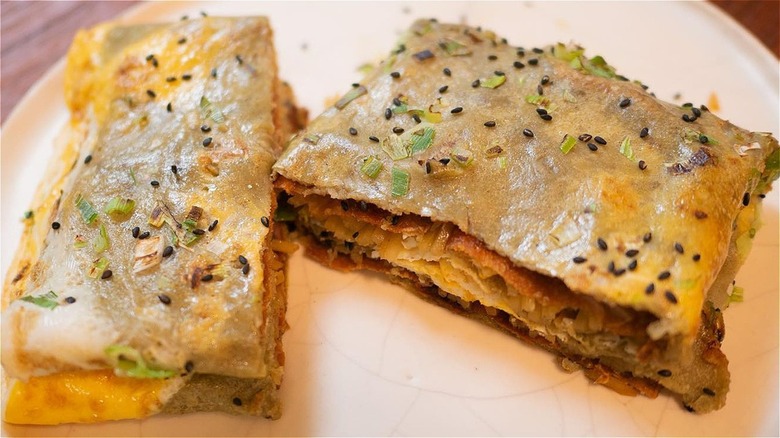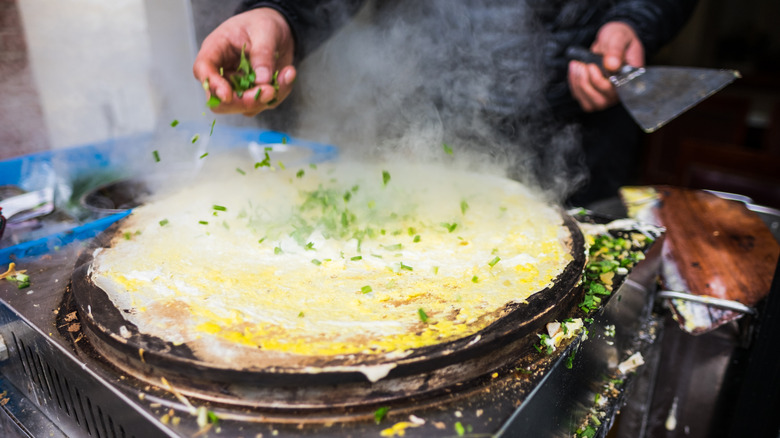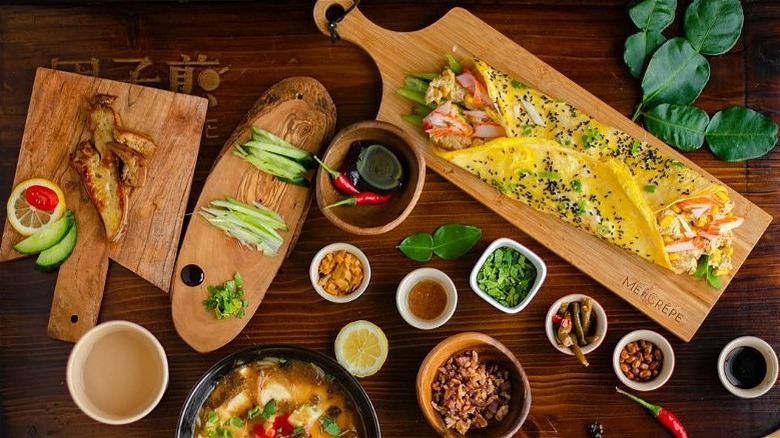Jianbing Is The Chinese Street Food That Combines Eggs And Crepes
Commuters and early risers in China are all too familiar with the scent of that country's famous breakfast-time street food wafting through the morning air. Come sunrise, there are jianbing stalls appearing on many street corners across the nation, set up by vendors who bring in hundreds of eggs precariously strapped to the back of their motorbikes.
With a name translating to "fried pancake," jianbing is a traditionally prepared savory dish with eggs wrapped in thin dough, like that you'd find in a crepe recipe. Tucked within the folded layers of jianbing are contrasting textures and flavors galore, from crisp and chewy to deliciously sweet and spicy. It's a filling and satisfying breakfast staple that locals will happily wait in line for, even if it means being late to work that day.
Stalls selling this queue-forming delicacy can be found in cities throughout China as early as 5 a.m. before slowly disappearing as peak lunch hours approach. Jianbing makes a killing practically every time, too, as it's one of the best street foods you can buy for $1. And various regions in China use different ingredients and fillings when creating their own unique versions of this made-to-order crepe.
Only in the 21st century has it become a dish many Americans love, as well. Trend-setting metropolises like LA and New York City have loads of eateries serving up authentic jianbing hot off the griddle. This savory breakfast comes with a long history, though, dating further back than most other Chinese street foods.
The ancient history behind jianbing
Jianbing's origin story is based on an ancient Chinese legend from the Shandong Province that involves a military strategist, Zhuge Liang, and his army of hungry soldiers. This culinary tale is nearly 2,000 years old, dating back to one of China's most violent eras, the Three Kingdoms period, which lasted from A.D. 220 to 280. Amidst the chaos and exhaustion of war, Liang's army lost the woks they had intended to cook with, prompting the need for a little extra creativity.
Ordering his men to concoct a dough, Liang decided that having no woks was no issue, and the soldiers instead used their shields to cook up some thin jianbing pancakes. After tossing their ingredients onto their makeshift woks, Liang's troops feasted on the now-widely popular breakfast food, which is said to have helped carry them to victory afterward.
However, Brian Goldberg — the founder and CEO of Mr. Bing (a New York, jianbing-serving company) — told Food Republic of another anecdote that describes the plight of a man sent to prison for swiping a steamed bun. While he served his sentence, his wife visited him frequently, giving him the chance to complain about the prison's poor food quality. Thus, on her subsequent visits, she delivered homemade jianbing that lacked much thickness, allowing it to be slid under cell bars for her imprisoned spouse to enjoy.
Common jianbing ingredients and fillings
Making jianbing is a process that relies on special techniques in order to produce a tasty final product. There are many unique variations of this savory dish that can be found throughout China's many regions, from the North's usage of black bean flour to Eastern China's combination of wheat and mung bean flour. The latter tends to be the standard form of jianbing batter used by vendors in general.
Besides the fried batter and eggy spread found in an authentic jianbing recipe, other ingredients like scallions, cilantro, and lettuce can be sprinkled into its crispy folds. An umami-infused combo of fermented bean curd, hoisin sauce, and chili is often added according to each customer's preference. Some areas in China will throw in crispy bacon strips, chicken, and sometimes fried dough sticks or crackers, too.
For those keen on making jianbing at home, a large cast iron pan or comal is necessary to distribute the stovetop's heat evenly. Wheat flour and mung bean flour are combined with water and salt, forming a thin batter that's spread onto a lightly oiled pan over medium heat. Eggs are cracked over the pan and spread evenly until cooked. After adding scallions, the crepe is flipped and smattered with fermented mung bean and other flavorful sauces. Finally, the piping hot pancake is topped with lettuce and other herbs before its folded and halved. Local vendors can cook these at lightning-fast speeds, though, so it will take longer if you're opting for a homemade approach to jianbing.
Where to find jianbing in the U.S.
If recreating your own jianbing at home simply isn't in the cards for you, there are quite a few Stateside hotspots where you can have it made by the pros. For instance, the eclectic food scene in and around LA is home to a number of restaurants specializing in various Asian cuisines, including some that serve expertly-made, Chinese-style crepes to hungry crowds. One such eatery is Pasadena, California's Me + Crepe, which is near-entirely dedicated to jianbing, offering crepes stuffed with meats like Peking duck, golden tuna, and braised pork belly. Another hidden gem around LA is called Ai Wei Ju, where one TikTok user rushed to sample its beef jianbing after never seeing the dish made anywhere in the U.S. before.
@jenz_losangeles Chinese street crepes in the 626 near #la 📍Ai Wei Ju #losangeles #chinese #streetfood #foodie #breakfast #hiddengem #wheretoeat #unique
The video's comments are filled with mentions of jianbing eateries in New York City, Seattle, and Portland. However, scoring one of these savory treats isn't something to be rushed. Lines will form and wait times will be inevitable, similar to how it works at jianbing street food stands throughout China. Not only that, but the American prices that are slapped onto these fancy crepes aren't nearly as jaw-droppingly low as those found in China. Regardless, this is one culturally rich dish that's definitely worth experiencing, even just once.
Static Media owns and operates Mashed and Food Republic.



